Razorbill
The razorbill or lesser auk[2] (Alca torda) is a colonial seabird in the monotypic genus Alca of the family Alcidae, the auks. It is the closest living relative of the extinct great auk (Pinguinis impennis).[3] Wild populations live in the subarctic waters of the Atlantic Ocean.
| Razorbill | |
|---|---|
| At Westfjords peninsula, Iceland | |
| Scientific classification | |
| Kingdom: | Animalia |
| Phylum: | Chordata |
| Class: | Aves |
| Order: | Charadriiformes |
| Family: | Alcidae |
| Genus: | Alca Linnaeus, 1758 |
| Species: | A. torda |
| Binomial name | |
| Alca torda | |
 | |
Razorbills are primarily black with a white underside. The male and female are identical in plumage; however, males are generally larger than females. This agile bird, which is capable of both flight and diving, has a predominantly aquatic lifestyle and only comes to land in order to breed. It is monogamous, choosing one partner for life. Females lay one egg per year. Razorbills nest along coastal cliffs in enclosed or slightly exposed crevices. The parents spend equal amounts of time incubating, and once the chick has hatched, they take turns foraging for their young.
In 1918, the razorbill was protected in the United States by the Migratory Bird Treaty Act. Presently, the major threat for the population is the destruction of breeding sites.[4]
Taxonomy

The razorbill is the sole species in the genus Alca. Its close relative, the great auk, became extinct in the mid-19th century. Razorbills and great auks are part of the tribe Alcini, which also includes the common murre or common guillemot (Uria aalge), the thick-billed murre (Uria lomvia) and the dovekie (Alle alle).[5] The genus name Alca is from Norwegian Alke, and torda is from törd a Gotland Swedish dialect word. Both terms refer to this species.[6]
There are two subspecies of razorbill recognized by the American Ornithologists' Union. Alca torda torda, named by Linnaeus in 1758, occurs in the Baltic and White Seas, Norway, Bear Island, Iceland, Greenland, and eastern North America. Alca torda islandica, named by C.L. Brehm in 1831, occurs throughout Ireland, Great Britain and northwestern France. The two subspecies differ slightly in bill measurements. A third subspecies, Alca torda pica, is no longer recognized because the distinguishing characteristic, an additional furrow in the upper mandible, is now known to be age-related.
Description
_(cropped).jpg)
The razorbill has white belly and a black head, neck, back and feet during the breeding season. A thin white line also extends from the eyes to the end of the bill. Its head is darker than that of a common murre. During the non-breeding season, the throat and face behind the eye become white, and the white line on the face and bill becomes less prominent.[7] The bill is black, deep and laterally compressed, with a blunt end. It has several vertical grooves or furrows near the curved tip, one of them adorned with a white, broken vertical line. The bill is thinner and the grooves are less marked during the non-breeding season. It is a large and thick-set bird, for an alcid, and its mean weight ranges from 505 to 890 g (17.8 to 31.4 oz).[8] The female and male adults are very much alike, having only small differences such as wing length. It is 37-39 cm in body length, the wing length of adult males ranges from 201–216 mm (7.9–8.5 in) while that of females ranges from 201 to 213 mm (7.9 to 8.4 in).[9] During incubation, this species has a horizontal stance and the tail feathers are slightly longer in the center in comparison to other alcids. This makes the razorbill have a distinctly long tail which is not common for an auk. In flight, the feet do not protude beyond the tail.
Their mating system is female-enforced monogamy; the razorbill pairs for life. It nests in open or hidden crevices among cliffs and boulders. It is a colonial breeder and only comes to land to breed. The annual survival rate of the razorbill is between 89-95%.[10] Though the razorbill's average lifespan is roughly 13 years, a bird ringed in the UK in 1967 survived for at least 41 years—a record for the species.[11]
Distribution and habitat
Razorbills are distributed across the North Atlantic; the world population of razorbills is estimated to be at less than 1,000,000 breeding pairs, making them among the rarest auks in the world (Chapdelaine et al. 2001). Approximately half of the breeding pairs occur in Iceland. Razorbills thrive in water surface temperature below 15 °C. They are often seen with other larger auks, such as the thick-billed murre and common murre. However, unlike other auks, they commonly move into larger estuaries with lower salinity levels to feed. These birds are distributed across sub-arctic and boreal waters of the Atlantic. Their breeding habitat is islands, rocky shores and cliffs on northern Atlantic coasts, in eastern North America as far south as Maine, and in western Europe from northwestern Russia to northern France. North American birds migrate offshore and south, ranging from the Labrador Sea south to the Grand Banks of Newfoundland to New England. Eurasian birds also winter at sea, with some moving south as far as the western Mediterranean. Approximately 60 to 70% of the entire razorbill population breeds in Iceland.[12]
Razorbill colonies include (north to south):
- Grímsey, Iceland (66°33' N)
- Látrabjarg, Iceland (65°30' N) - 230,000 pairs, about 40% of the global population (mid-1990s estimate). Breeding season June - July.[13]
- Runde, Norway (62°24' N) - 3,000 pairs
- Staple Island, Outer Farne Islands, UK (55°38' N) - 20,000 pairs, breeding season May to mid-July.
- Bempton Cliffs, [Flamborough and Filey Coast Special Protection Area ]United Kingdom (54°14’ N) - 20,000 pairs from March to mid July.
- Heligoland, Germany (54°10' N) - near southern limit in Europe, a few pairs only
- Gannet Islands, Canada (53°58' N) - 9,800 pairs[14]
- Funk Island, Canada (49°45' N)
- Baccalieu Island, Canada (48°07' N)
- Witless Bay, Canada (47°13' N)
- Cape St. Mary's, Canada (46°49' N)
Behaviour
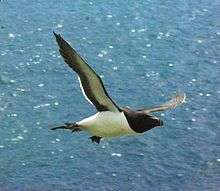
The life history traits of the razorbill are similar to that of the common murre. However, razorbills are slightly more agile. During breeding, both male and female protect the nest. Females select their mate and will often encourage competition between males before choosing a partner.[15] Once a male is chosen, the pair will stay together for life.
Reproduction
Individuals only breed at 3–5 years of age. As pairs grow older they will occasionally skip a year of breeding. A mating pair will court several times during breeding periods to strengthen their bond.[8] Courtship displays include touching bills and following one another in elaborate flight patterns. Once the pre-laying period begins, males will constantly guard their mates by knocking other males away with their bills.[8] The pair will mate up to 80 times in a 30-day period to ensure fertilization.[16] Females will sometimes encourage other males to engage in copulation to guarantee successful fecundity.[15]
Throughout the pre-laying period razorbills will socialize in large numbers. There are two types of socializing that occur. Large groups will dive and swim together in circles repeatedly and all rise up to the surface, heads first and bills open. Secondly, large groups will swim in a line weaving across each other in the same direction.
Nest sites
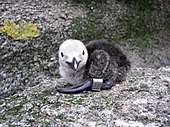
Nest site choice is very important for these birds to ensure protection of young from predators. Unlike murres, nest sites are not immediately alongside the sea on open cliff ledges but at least 10 cm (3.9 in) away, in crevices on cliffs or among boulders. Nests are usually confined among the rocks or slightly more open. Some sites are along ledges, however, crevice sites seem to be more successful due to reduced predation.[17]
The mating pair will often reuse the same site every year.[18][19] Since chicks do not have the ability to fly nests close to sea provide easy access when leaving the colony. Generally razorbills do not build a nest; however, some pairs often use their bills to drag material upon which to lay their egg.[20] Nest under boulder, rarely on exposed ledge, may use Puffin or rabbit burrow [21]. Although gregarious in breeding colonies, nests are not contiguous, but some meters apart, resulting in less aggression than in Guillemot colonies [21].
Incubation and hatching
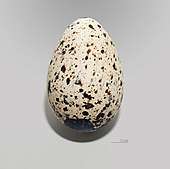
Females lay a single egg per year, usually from late April to May. The egg is an ovoid-pyramidal shape, cream color with has dark brown blotches. Incubation starts generally 48 hours after laying the egg. Females and males take turns incubating the egg several times daily for a total of approximately 35 days before hatching occurs. Razorbill chicks are semi-precocial.[22] During the first two days after hatching, the chick will spend the majority of its time under the parent's wing. There is always one parent at the nest site while the other goes to sea to collect food for the chick. The hatchling develops a complete sheath 10 days after hatching. After 17–23 days the chick leaves nest jumping from cliff, closely followed by male parent, who will accompany the chick to sea.
Feeding
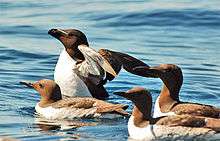
Razorbills dive deep into the sea using their semi-folded wings and their streamlined bodies to propel themselves toward their prey. They keep their feet spread. While diving, they rarely stay in groups, but rather spread out to feed. The majority of their feeding occurs at a depth of 25 m (82 ft) but they have the ability to dive up to 120 m (390 ft) below the surface.[23] During a single dive an individual can capture and swallow many schooling fish, depending on their size. Razorbills spend approximately 44% of their time foraging at sea.[24]
When feeding their young, they generally deliver small loads. Adults will mainly feed only one fish to their chick with high feeding deliveries at dawn and decreased feeding 4 hours before dark.[8] Females will generally feed their chicks more frequently than males.[24] They may well fly more than 100 km (62 mi) out to sea to feed when during egg incubation, but when provisioning the young, they forage closer to the nesting grounds, some 12 km (7.5 mi) away, and often in shallower water.[13]
Diet
The diet of a razorbill is very similar to that of a common murre or common guillemot. It consists generally of mid water schooling fish such as capelin, sand lance, juvenile cod, sprats and herring. It may also include crustaceans and polychaetes. A recent study suggests the razorbill's diet is affected by local and regional environmental conditions in the marine environment [19]
Predators
The adult razorbill has several predators which include: polar bears, great black-backed gulls, peregrine falcons, ravens, crows and jackdaws. The general predators of their eggs are gulls and ravens. The best chance for an adult razorbill to avoid predation is by diving. Arctic foxes can also predate significant numbers of adults, eggs, and chicks in some years.[25]
Conservation and management
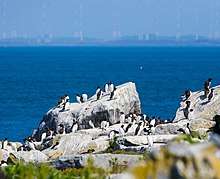
In the early 20th century, razorbills were harvested for eggs, meat and feathers. This greatly decreased the global population. In 1917, they were finally protected by the “Migratory Bird Treaty Act” which reduced hunting.[8] Other threatening interactions include oil pollution which can damage breeding sites. Any damage to breeding sites can reduce possible nest sites and affect reproduction of the species. Commercial fishing affects populations because razorbills can become tangled in nets. Overfishing also decreases the abundance of razorbill prey and thus affects their survival.
Evolution and prehistoric species
While the razorbill is the only living species, the genus Alca had a much higher diversity in the Pliocene. Some ornithologists also feel it is appropriate to retain the great auk in the genus Alca, instead of Pinguinus.[26] A number of fossil forms have been found:
- Alca "antiqua" (Late Miocene/Early Pliocene of Lee Creek Mine, USA)
- Alca sp. (Late Miocene/Early Pliocene of Lee Creek Mine, USA) - possibly A. stewarti
- Alca stewarti (Kattendijk Sands Early Pliocene of Belgium)
- Alca ausonia (Yorktown Early Pliocene of Lee Creek Mine, USA - Middle Pliocene of Italy)
- Alca sp. (Puerto de Mazarrón Pliocene of El Alamillo, Spain) - may be A. antiqua or A. ausonia
As far as is known, the genus Alca seems to have evolved in the western North Atlantic or the present-day Caribbean like most other Alcini. Its ancestors would have reached these waters through the still-open Isthmus of Panama during the Miocene.[27]
References
- BirdLife International (2015). "Alca torda". IUCN Red List of Threatened Species. 2015. Retrieved 24 January 2016.CS1 maint: ref=harv (link)
- Proceedings of the Society of Antiquaries of Scotland, Volume 13 (Edinburgh: Society of Antiquaries of Scotland, 1879), ISBN 9781248434567
- Moum, Truls; Arnason, Ulfur; Árnason, Einar (2002). "Mitochondrial DNA sequence evolution and phylogeny of the Atlantic Alcidae, including the extinct Great Auk (Pinguinus impennis)" (PDF). Molecular Biology and Evolution. Oxford: Oxford University Press. 19 (9): 1434–1439. doi:10.1093/oxfordjournals.molbev.a004206. PMID 12200471. Retrieved 8 May 2009.
- Lavers, Jennifer; Hipfner, J. Mark; Chapdelaine, Gilles (28 October 2009). "Razorbill - Introduction - Birds of North America Online". birdsna.org. Retrieved 2018-09-06.
- Friesen, V.L.; Baker, A.J.; Piatt, J.F. (1996). "Phylogenetic relationships within the Alcidae (Charadriiformes: Aves) inferred using total molecular evidence". Molecular Biology and Evolution. 13 (2): 359–367. doi:10.1093/oxfordjournals.molbev.a025595. PMID 8587501.
- Jobling, James A (2010). The Helm Dictionary of Scientific Bird Names. London: Christopher Helm. pp. 39, 388. ISBN 978-1-4081-2501-4.
- "Razorbill Fact Sheet". Lincoln Park Zoo. Archived from the original on 29 September 2011.
- Conder, P.J. (1950). "On the courtship and social displays of three species of auk". British Birds. 43: 65–69.
- Gaston, Anthony J.; Jones, Ian L. (1998). The Auks: Alcidae. Bird Families of the World. New York: Oxford University Press. pp. 126–132. ISBN 978-0198540328.
- Lavers, J.L.; Jones, I.L.; Diamond, A.W.; Robertson, G.J. (2008). "Annual survival of North American Razorbills (Alca torda) varies with ocean climate indices". Canadian Journal of Zoology. NRC Research Press. 86 (1): 51–61. doi:10.1139/Z07-113.
- McCarthy, Michael (10 July 2008). "Seabird Born in Summer of Love Still Breeding in Wales". The Independent. London. Retrieved 10 July 2008.
- Lavers, J.L.; Hipfner, M.J.; Chapdelaine, G.C. (2009). The Birds of North America. 16. Philadelphia, PA: The Birds of North America, Inc.
- Lilliendahl, K.; Solmundsson, J.; Gudmundsson, G.A.; Taylor, L. (2003). "Can surveillance radar be used to monitor the foraging distribution of colonially breeding alcids?". Condor (in English and Spanish). 105 (1): 145–150. doi:10.1650/0010-5422(2003)105[145:CSRBUT]2.0.CO;2.
- Chapdelaine, G.; Diamond, A.W.; Elliot, R.D.; Robertson, G.J. (2001). "Status and population trends of the Razorbill in eastern North America". Occasional Paper (105). Canadian Wildlife Service. Cite journal requires
|journal=(help) - Wagner, R.H. (1991). "Evidence that female Razorbills control extra pair copulations". Behaviour. BRILL. 118 (3/4): 157–169. doi:10.1163/156853991X00265. JSTOR 4534962.
- Wagner, R.H. (1992). "Confidence of paternity and parental effort in razorbills". The Auk. American Ornithologists' Union. 109 (3): 556–562. JSTOR 4088369.
- Plumb, W.J. (1965). "Observations on the breeding biology of the Razorbill" (PDF). British Birds. 58 (11): 449–456.
- Harris, M.P.; Wanless, S. (1989). "The breeding biology of Razorbills Alca torda on the Isle of May". Bird Study. 36 (2): 105–114. doi:10.1080/00063658909477012.
- Lavers, J.L.; Jones, I.L. (2007). "Factors affecting rates of intraspecific kleptoparasitism and breeding success of the Razorbill at the Gannet Islands, Labrador" (PDF). Marine Ornithology. 35 (1): 1–7.
- Williams, A.J. (1971). "Laying and nest-building behavior in the larger auks (Aves, Alcidae)". Astarte. 4: 61–67.
- Snow, D. W. (1994). The Birds of the Western Palearctic. Oxford University Press. ISBN 0-19-850187-0.
- Ralph, C. John; Hunt, Jr., George L.; Raphael, Martin G.; Piatt, John F., eds. (1995). "Ecology and Conservation of the Marbled Murrelet". PSW-152. Albany, California: USDA Forest Service. Cite journal requires
|journal=(help) - Piatt, J.F.; Nettleship, D.N. (1985). "Diving depths of four alcids". The Auk. 102 (2): 293–297. doi:10.2307/4086771. JSTOR 4086771.
- Thaxter, Chris B.; Daunt, Francis; Hamer, Keith C.; Watanuki, Yutaka; Harris, Mike P.; Grémillet, David; Peters, Gerrit; Wanless, Sarah (2009). "Sex-specific food provisioning in a monomorphic seabird, the common guillemot Uria aalge: nest defence, foraging efficiency or parental effort?". Journal of Avian Biology. 40 (1): 75–84. doi:10.1111/j.1600-048x.2008.04507.x.
- Lavers, J.L.; Jones, I.L.; Robertson, G.J.; Diamond, A.W. (2009). "Contrasting population trends at two Razorbill colonies in Atlantic Canada: additive effects of fox predation and hunting mortality?". Avian Conservation and Ecology. 4 (2): 3–17. doi:10.5751/ACE-00322-040203.
- Fuller, Errol (1999). The Great Auk (Illustrated ed.). Southborough, Kent, UK: Privately Published. p. 401. ISBN 0-9533553-0-6.
- Bédard, J. (1985). Nettleship, David N.; Birkhead, Tim R. (eds.). Evolution and characteristics of the Atlantic Alcidae. The Atlantic Alcidae. London: Academic Press. pp. 6–19. ISBN 0-12-515671-5.
External links
| Wikimedia Commons has media related to Alca torda. |
| Wikispecies has information related to Alca torda |
- "Razorbill media". Internet Bird Collection.
- Razorbill photo gallery at VIREO (Drexel University)
- Interactive range map of Alca torda at IUCN Red List maps
- Audio recordings of Razorbill on Xeno-canto.
